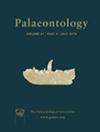旧大陆新近纪和更新世哺乳动物的连贯生物地理框架
IF 2.3
2区 地球科学
Q1 PALEONTOLOGY
引用次数: 0
摘要
为了了解哺乳动物的进化并计算广泛的生物多样性指数,我们通常使用“生物区域”,这是一种适应生态和进化约束的空间划分。虽然通常由新生物学家进行,但古生物学中生物区域的建立通常是一种二次分析,以主观的时间尺度和特定于所调查问题和群体的区域为基础。这种异质性,加上生物多样性指数的规模依赖性,阻碍了对已灭绝哺乳动物等大型分类学群体的宏观生态和宏观进化趋势的明确识别。在这里,我们通过以下两个步骤为旧大陆的新近纪和更新世哺乳动物提供一个连贯的框架来解决这个问题:(1)通过多队列分析来定义适应哺乳动物进化史的时间尺度(即进化动物群);(2) 然后,通过聚类、排序和中间方法,在欧亚大陆和非洲的多个空间尺度(即大陆到区域)上计算每个进化动物的生物区域。此外,我们的研究结果为广泛的哺乳动物数据集提供了一个连贯的框架,表明:(1)在从时代到地质阶段的时间尺度上,发现了五种哺乳动物进化动物群的同步出现和衰落;(2) 中新世和上新世之间从纵向到横向的生物地理结构转变,尤其是在欧洲;(3) 南亚与非洲动物群的长期亲缘关系,与现代古北界生物区系的扩展形成鲜明对比;以及(4)从中新世晚期的碎片区域到更新世的完整区域,建立了一个巨大的地中海生物区。本文章由计算机程序翻译,如有差异,请以英文原文为准。
A coherent biogeographical framework for Old World Neogene and Pleistocene mammals
In order to understand mammalian evolution and compute a wide range of biodiversity indices, we commonly use the ‘bioregion’, a spatial division adapted to ecological and evolutionary constraints. While commonly conducted by neontologists, the establishment of bioregions in palaeontology is generally a secondary analysis, shaped on subjective time scales and areas specific to the investigated questions and groups. This heterogeneity, coupled with the scale‐dependency of biodiversity indices, prevents the clear identification of macroecological and macroevolutionary trends for large taxonomic groups like extinct mammals. Here we tackle this issue by providing a coherent framework for Neogene and Pleistocene mammals of the Old World following two steps: (1) a temporal scale adapted to mammalian evolutionary history (i.e. evolutionary fauna) is defined by poly‐cohort analysis; (2) bioregions are then computed for each evolutionary fauna by clustering, ordination and intermediate approaches at multiples spatial scales (i.e. continental to regional) for Eurasia and Africa. Additionally, providing a coherent framework for a wide range of mammalian datasets, our results show: (1) the synchronous emergence and fall of five mammalian evolutionary faunas identified at chronological scales varying from the epoch to the geological stage; (2) a transition from a longitudinal to a latitudinal biogeographical structuring between the Miocene and Pliocene, especially in Europe; (3) the long‐term affinity of southern Asian with African faunas, in sharp contrast with the modern Palaearctic bioregion extension; and (4) the establishment of a vast Mediterranean bioregion from fragmented areas in the Late Miocene to its full extent in the Pleistocene.
求助全文
通过发布文献求助,成功后即可免费获取论文全文。
去求助
来源期刊

Palaeontology
地学-古生物学
CiteScore
5.60
自引率
3.80%
发文量
43
审稿时长
6 months
期刊介绍:
Palaeontology publishes a wide variety of papers on palaeontological topics covering:
palaeozoology
palaeobotany
systematic studies
palaeoecology
micropalaeontology
palaeobiogeography
functional morphology
stratigraphy
taxonomy
taphonomy
palaeoenvironmental reconstruction
palaeoclimate analysis and biomineralization studies.
 求助内容:
求助内容: 应助结果提醒方式:
应助结果提醒方式:


